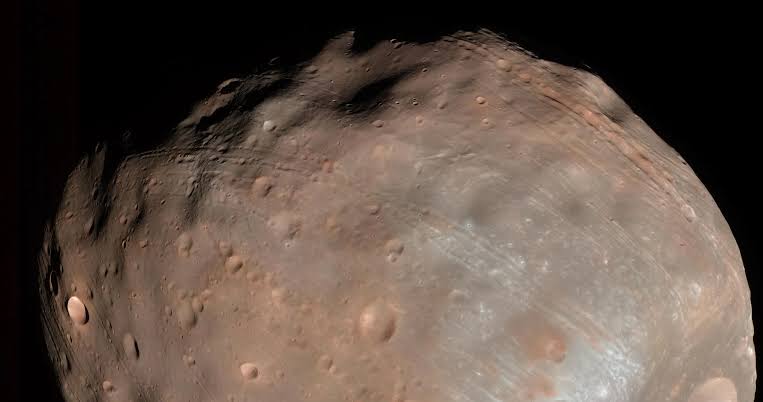Phobos, a moon of Mars, is passing quickly across the cosmos. Calculations by astronomers show that the potato-shaped satellite is slowly but steadily approaching its host planet. The gravitational force between the two bodies will eventually split Phobos apart in around 100 million years, giving the red planet a brief dust ring.
What Are The New Observations?
A recent study suggests that the gravitational interactions may already be having an impact that can be seen. The moon’s mysterious parallel shallow grooves, which run over its whole surface, may have fractured as its orbit slowly deteriorates and tidal forces pull at its core more and more.
According to research performed by Bin Cheng of Tsinghua University in China and the University of Arizona, “our study supports a layered heterogeneous structure for Phobos with likely underlying failure-induced fractures, as the precursor of the final end of the de-orbiting satellite.”
The Gravitational Contact
The gravitational contact between the bodies in a system causes tidal forces that tug on them, extending their structural relationships along an axis that runs between them.
The likelihood of this distortion having a significant impact on a solid surface is typically quite low. The visible effects of tidal forces on large land masses are less clear than those on the motions of our planet’s liquid oceans.
However, this does not rule out the possibility of more glaring effects from tidal forces between other solid entities. Tidal stretching can occasionally result in stress fracturing. This is demonstrated by Enceladus, a moon of Saturn, which has deep, parallel fractures in its icy shell at its south pole brought on by tidal stress.
Significance Of Phobos
Phobos orbits Mars in just 7 hours and 39 minutes, getting closer to Mars at a pace of about 1.8 cm every year. It is undoubtedly possible that tidal forces at that distance could cause surface fracturing on its 27 km (16.8 mi) wide body. The theory that such an interaction produced Phobos’ stripes has also been thought about in the past and was deemed plausible.
However, it’s unclear whether Phobos and Mars’ current alignment and interaction could cause the observed striping, and there are other possibilities as well. For example, a 2018 study discovered that the stripes might be caused by moving stones.
Observation Of The Tidal Stretching
In order to specifically study the tidal stretching and constriction of a layered body resembling Phobos, with a loose, rubbly exterior sitting over a cohesive layer below, Cheng and his colleagues conducted 3D mathematical modeling.
Using their model, the researchers ran hundreds of simulations. The cohesive layer separated and fractured in parallel grooves in a large majority of these models, allowing the overlying loose regolith to drain into the fractures below. The end result is a surface that is striated and striped, very much like parts of Phobos.
The Grooves Near The Moon’s Equator
The scientists discovered that not all sections of Phobos were consistent with the hypothesis. Particularly, grooves near the moon’s equator deviated from expectations. The findings do, however, indicate that at least some of the stripes may have resulted from fracturing as the moon spiraled towards death by tidal dismemberment. This would indicate that Phobos is approaching its demise.
Therefore, these findings might have ramifications for research on other moons, including Neptune’s moon Triton, that are significantly decaying in their orbits. The grooves could be a very fascinating area to explore for the next Japanese Space Agency Mars moon mission because the draining rubble could also disclose pristine material on Phobos.
Conclusion
Tidal disruption undoubtedly seems to be an intriguing possibility, but this mission is expected to deliver definitive evidence of the origin of these mysterious stripes. The researchers discovered that the tidal strain might produce parallel fractures with regular spacing when they model Phobos as a rubble-pile interior covered by a cohesive covering.
“Our analysis reveals that some of the grooves running Phobos’ surface are probably early indicators of the deorbiting satellite’s eventual doom.”
